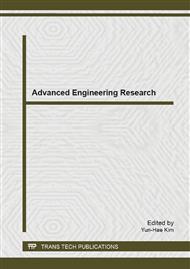[1]
Ouattara,B., Simard R.E., Piette,G., et al. Diffusion of acetic and propionic acids from chitosan-based antimicrobial packaging films[J]. Journal of Food Science, 2000, 65(5), 768–773.
DOI: 10.1111/j.1365-2621.2000.tb13584.x
Google Scholar
[2]
Siragusa G.R., Dickson J.S., Inhibition of Listeria monocytogenes on beef tissue by application of organic acids immobilized in a calcium alginate gel[J]. Journal of Food Science, 1992, 57(2), 293–296.
DOI: 10.1111/j.1365-2621.1992.tb05479.x
Google Scholar
[3]
Gennadios,A., Weller C.L., Edible films and coatings from wheat and corn proteins[J]. Food Technology, 1990, 44(10), 63–69.
Google Scholar
[4]
Rico-Pena D.C., Torres J.A., Sorbic acid and potassium sorbate permeability of an edible methylcellulose-palmitic acid films: water activity and pH effects[J]. Journal of Food Science, 1991, 56(2), 497–499.
DOI: 10.1111/j.1365-2621.1991.tb05312.x
Google Scholar
[5]
Kokoszka, S., Debeaufort, F., Lenart, A., Voilley, A. Water Vapour Permeability, Thermal and Wetting Properties of Whey Protein Isolate Based Edible Films[J]. International Dairy Journal. 2010, (1): 53-60.
DOI: 10.1016/j.idairyj.2009.07.008
Google Scholar
[6]
G.Y. Chen,Q. Lei: Research on Preparation and Properties of Edible Composite Protein Films[J]. Applied Mechanics and Manufacturing Technology, 2011, (87): 213-222.
DOI: 10.4028/www.scientific.net/amm.87.213
Google Scholar
[7]
Abugroun H.A., Cousin N.A., Judge M.D., Extended shelf life of unrefrigerated prerigor cooked meat[J]. Meat Science, 1993(33): 207–229.
DOI: 10.1016/0309-1740(93)90060-u
Google Scholar
[8]
Z.G. Yang, Preparation and antibacterial properties of nano-TiO2 particles and nanotubes[D]. Qingdao: Qufu Normal University, (2009).
Google Scholar
[9]
Schulz,J., Hohenberg,H., Pflücker,F., et al. Distribution of sunscreens on skin[J]. Advanced Drug Delivery Review. 2002, 54(1), 157-163.
DOI: 10.1016/s0169-409x(02)00120-5
Google Scholar
[10]
Tao, Y., Pan, J., Yan, S., et al. Tensile strength optimization and characterization of chitosan/TiO2 hybridfilm[J]. Materials Science and Engineering B: Solid-State Materials for Advanced Technology. 2007, 138(1), 84-89.
DOI: 10.1016/j.mseb.2006.12.013
Google Scholar
[11]
Zhou J.J., Wang, S.Y., & Gunasekaran,S. Preparation and characterization of whey protein film incorporated with TiO2 nanoparticles. Journal of Food Science, 2009, 74(7), 50-56.
Google Scholar
[12]
Ghasemlou, M, Khodaiyan, F, Oromiehie,A. Physical, mechanical, barrier, and thermal properties of polyol-plasticized biodegradable edible film made from kefiran[J]. Carbohydrate Polymers, 2011, 84(1): 477-483.
DOI: 10.1016/j.carbpol.2010.12.010
Google Scholar
[13]
ASTM, 2009. Designation: D882–09: Standard Test Method for Tensile Properties of Thin Plastic Sheeting.
Google Scholar
[14]
ASTM D1003-61, 1997: Standard Test Method for Haze and Luminous Transmittance of Transparent Plastics.
Google Scholar
[15]
ASTM E-398, 2003: Standard Test Method for Water Vapor Transmission Rate of Sheet Materials Using Dynamic Relative Humidity Measurement.
DOI: 10.1520/e0398-13
Google Scholar
[16]
C.D. Mu.L.M. Li and L. Wei et al: Preparation and properties of dialdehyde carboxyrnethyl cellulose crosslinked gelatin edible films [J]. Food Hydrocolloids, 2012, 27: 22-29.
DOI: 10.1016/j.foodhyd.2011.09.005
Google Scholar
[17]
C. Ping,K. Wang and L. Ma: Antimicrobial Activity and Solubility of Whey Protein Edible Film[J]. Meat Industry, 2012, (6): 35-37.
Google Scholar
[18]
M. Chen C.Y. Hu and Z.W. Wang et al: Effects of Vanillin on Antimicrobial Activity of Soy Protein Isolated Film[J]. Packaging Engineering, 2008, 29(10): 83-85.
Google Scholar
[19]
Y.X. Li,Y.F. Jiang and F. Liu, et al: Fabrication and characterization of TiO2/whey protein isolate nanocompositefilm[J]. Food Hydrocolloids. 2011, 25(5): 1098-1104.
DOI: 10.1016/j.foodhyd.2010.10.006
Google Scholar
[20]
M.J. Fabra, P. Talens and A. Chiralt: Journal of Food Engineering Vol. 96 (2010), pp.356-364.
Google Scholar
[21]
Hoque M.S., Benjakul,S., & Prodpran,T. (2011b). Effects of partial hydrolysis and plasticizer content on the properties of film from cuttlefish (Sepia pharaonis) skin gelatin. Food Hydrocolloids, 25, 82-90.
DOI: 10.1016/j.foodhyd.2010.05.008
Google Scholar
[22]
Martucci J.F., & Ruseckaite R.A. (2009). Tensile properties, barrier properties, and biodegradation in soil of compression-molded gelatin-dialdehyde starch films. Journal of Applied Polymer Science, 112, 2166-2178.
DOI: 10.1002/app.29695
Google Scholar
[23]
Cagri, A., Ustunol, Z., Ryser, E.T. et al. Antimicrobial, mechanical, and moisture barrier properties of low pH whey protein-based edible films containing p-Amminobenzoic or sorbic acid [J]. Journal of Food Science, 2001, 66(6), 865–870.
DOI: 10.1111/j.1365-2621.2001.tb15188.x
Google Scholar


